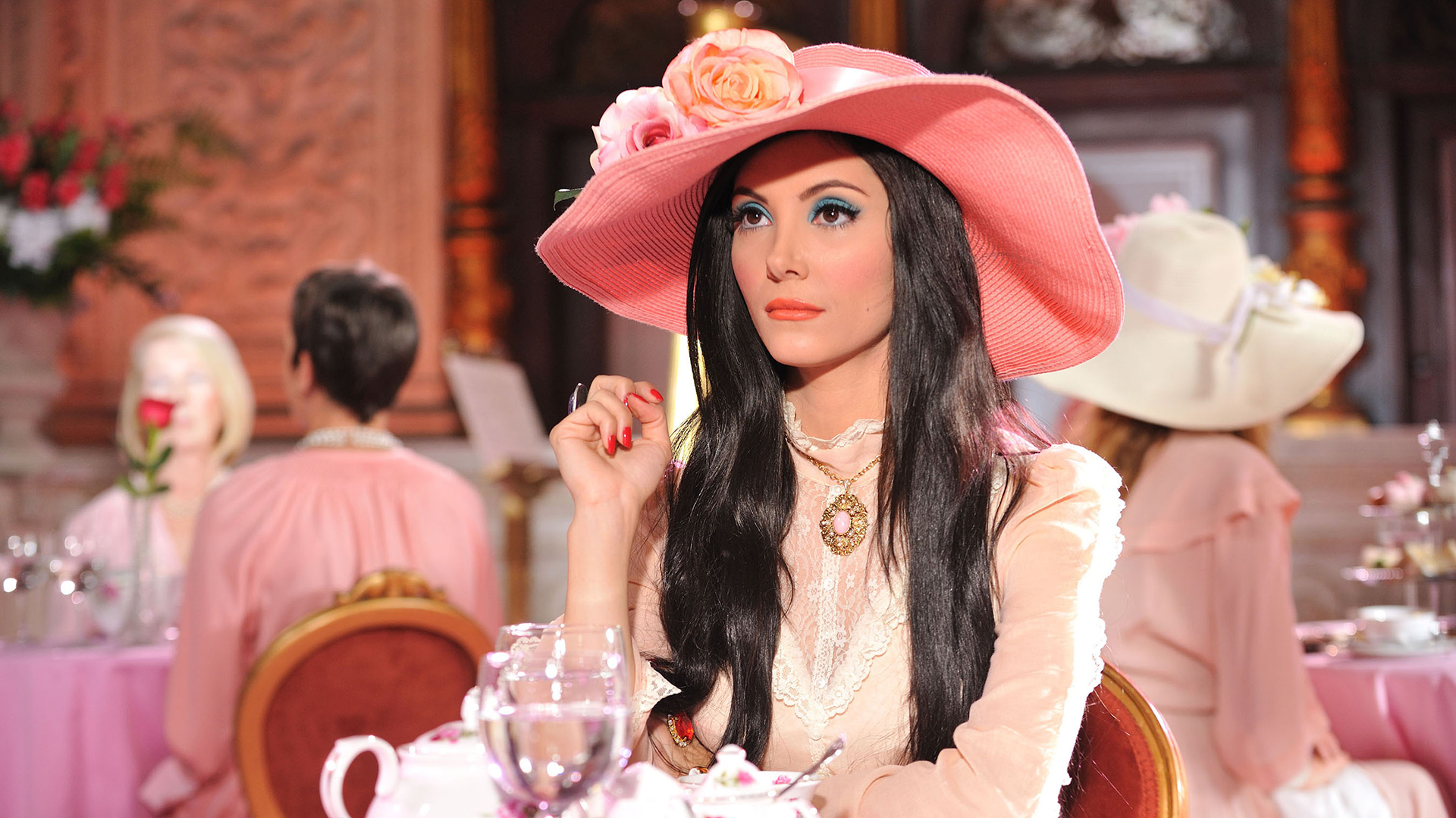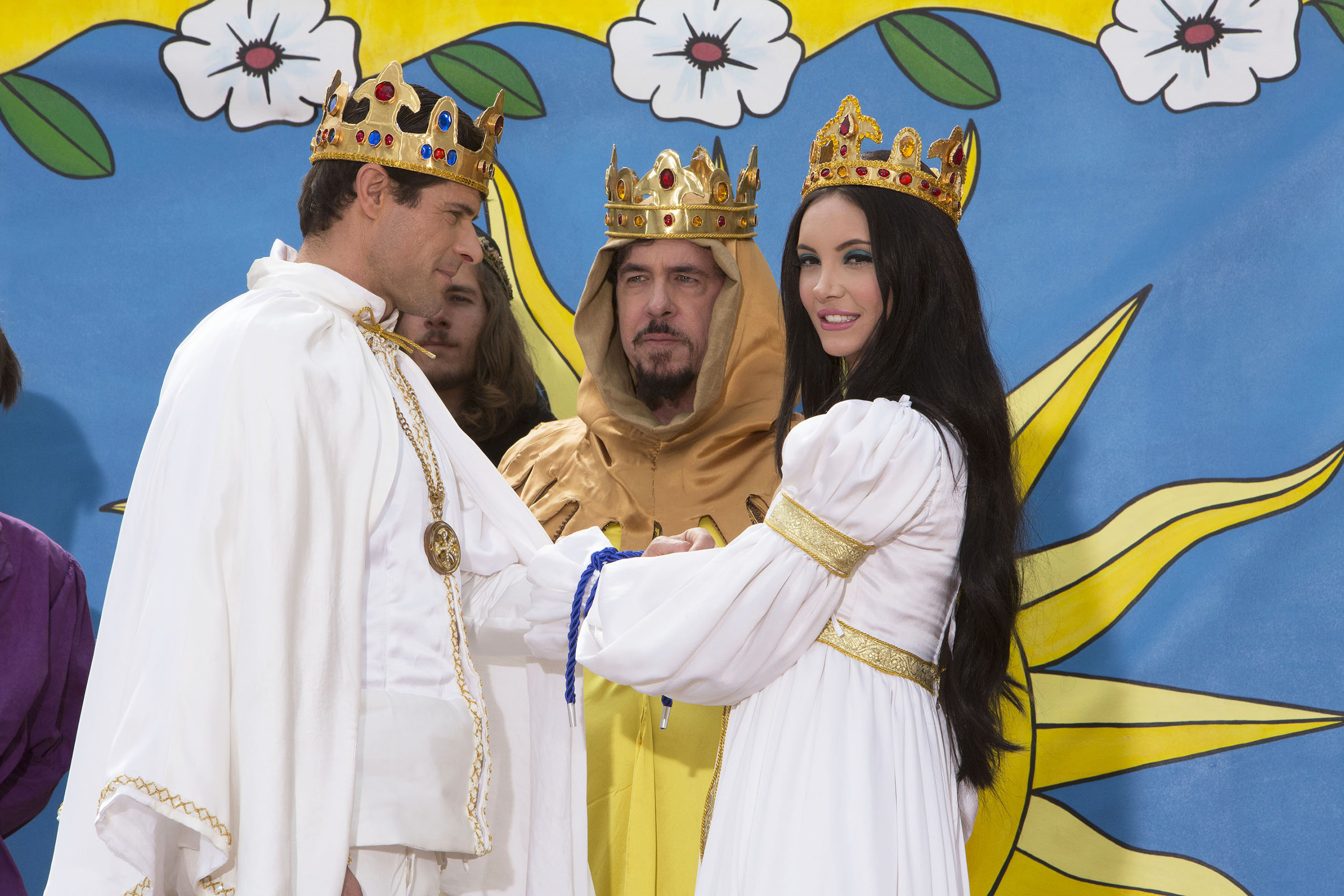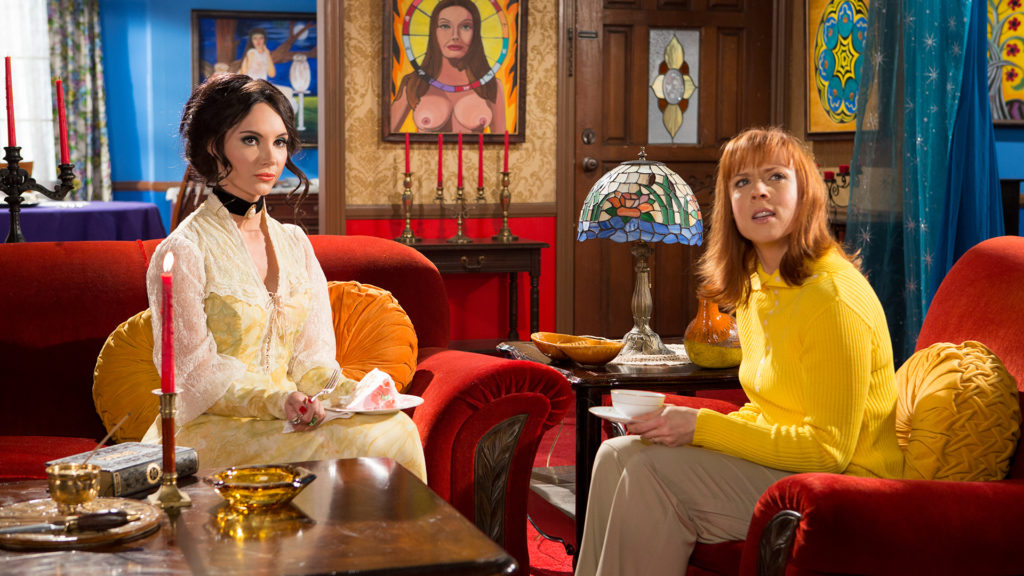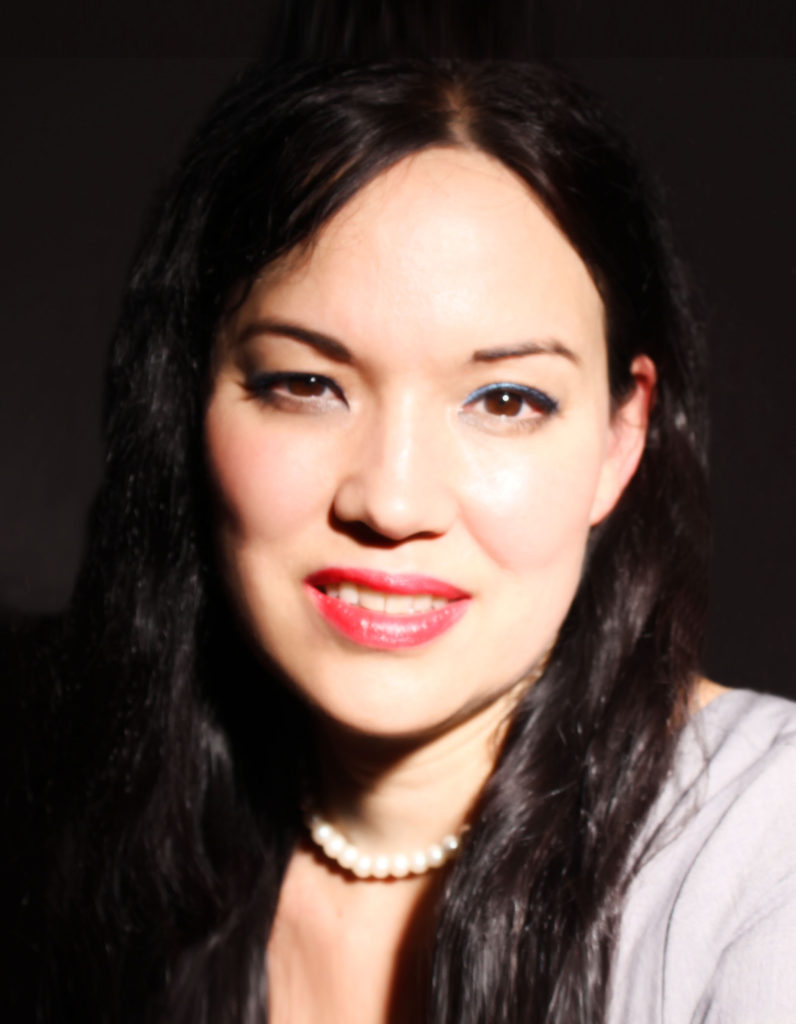It’s probably safe to say that ANNA BILLER puts more hours into her work than a lot of directors do, and with her newest passion project THE LOVE WITCH, it shows. Shot on 35mm celluloid, this years-in-the-making film takes inspiration from 1960s pulp novels, Technicolor Hollywood melodramas, and more, to tell the story of a woman looking for love. Samantha Robinson stars as Elaine, who just escaped a shaky relationship (under mysterious circumstances) and arrives in a new town ready to start fresh; and ready to use witchcraft to land the man of her dreams… at any cost. The final product is Biller’s vision through and through: Not only did she write the screenplay and produce, direct, and edit the film; she also hand-made every costume, designed the sets and many of the props, and composed the music.
A Los Angeles native, Biller holds an art degree from UCLA and an M.F.A. in art and film from CalArts. She made her first feature, the cult hit Viva, in 2007. Her follow-up to Viva, The Love Witch premiered at the Netherlands’ International Film Festival Rotterdam and has received high praise from critics and cinephiles during its festival tour for its distinct look and provocative story (SAGindie’s own Eliza Hajek calls the film “a MASTERPIECE” – caps lock intended).
The Love Witch co-stars Gian Keys, Laura Waddell, Jeffrey Vincent Parise, and Robert Seeley, and arrives in select theaters via Oscillocscope Laboratories on November 11, before expanding on November 18. We were so happy to talk with filmmaker Anna Biller to see how she pulled off such an ambitious feat as The Love Witch.
——
COLIN McCORMACK: I’ve heard various accounts of exactly how long the film took [to make]. Was it eight years?
ANNA BILLER: All together about seven years. About five years in pre-production and two years in production and post.
CM: And principal photography was how long?
AB: It was about eight weeks.
CM: When your financiers read the screenplay or heard your pitch, did you already know that you’d be doing all the sets and costumes yourself?
AB: With the budget that I was able to come up with, we didn’t actually have the money to hire designers in pre-production. [Laughs] There just wasn’t any more money, so we knew that I’d be doing them. I tried to get a little more in the budget to hire designers to help with costumes, but it turned out that was going to be way too much because of the nature of especially the period costumes.
CM: For costumes, how early did those come into play when you were creating the characters? Do you write details into the screenplay or do you flesh it out once the script is done?
AB: I write some things in because it’s so obvious to me that it needs to be a certain type of costume, and then I just start drawing the sets and the costumes and it all just comes together.
CM: Did you have a studio space that you worked in? It took many years, I assume, to get all the costumes designed and sewn.
AB: No, I have a little sewing room in my house. And it’s actually not even large enough to accommodate an assistant. We thought we could get the budget together for me to get me an assistant to help with hems and ironing and stuff, but I didn’t have space. [Laughs]
CM: Have you held onto all the costumes?
AB: Yeah, for the most part. Because some of them are generic and can be used again, especially the ones used for background. I have boxes and boxes and boxes of costumes in my garage, from this production and other productions.

CM: When it comes to the sets, that purple house that’s used as [Elaine’s landlord] Trish’s property is so fantastic. How long did it take you to find the right location?
AB: Well actually, my boyfriend suggested scouting up in Eureka and Arcata in Northern California. Once I did that I knew that’s where I wanted to shoot the exteriors, because there is all of this amazing Victorian architecture up there. So that was the only place outside of Los Angeles I scouted, and it turned out to be the right place. So all of those Victorian houses you see in the film are up in Eureka and Arcata.
CM: And the house was already that purple color?
AB: Yeah, that’s a historic Arcata house. We looked at different Victorians in Eureka and Arcata, but that was the best one.
CM: How did you connect with your cinematographer M. David Mullen?
AB: I actually had worked with him about fifteen years ago on a short (we went to the same school and knew the same people). And I saw how incredible he was with period-type lighting, because that film was also period — it took place in the ‘30s. He was like a wizard on set, so I knew he could do this. But he wasn’t available so I interviewed dozens of other D.P.s in the meantime while I was trying to get him, and I could never find anybody that understood how to do this classical style of lighting or was even interested in trying to do it. Because D.P.s have their own style, and hardly anybody shoots this way anymore [laughs]. But I knew that David had an interest in it and he had studied it extensively, so I just kept asking him and one day he said yes.
CM: So even more so than using like vintage lenses, it was the lighting that really gave that old glamorous Hollywood look?
AB: Yeah, the lighting is the most important thing. We also used vintage lenses and that helps too. But it’s every little thing – it’s the lighting, the lensing, and even the size of lenses you choose. They didn’t use a lot of wide-angle lenses in those days. And it’s also the design – designing with color. In black-and-white films, the lighting was the thing that separated the background from the foreground, and in color films the colors that were used on the sets and costumes were used for separation. Now films are lit with more of an overall glow where everything is in the same plane — that’s kind of the lighting that people like now. It’s supposed to look unlit. I mean, they are lighting it but they’re trying to make it look unlit. [Laughs]
CM: And while the visuals of the film have been receiving a lot of well-deserved attention, it really hinges a lot on Samantha Robinson’s performance. How did you go about casting that role and finding Samantha?
AB: When I first auditioned her she was still at UCLA. And she just came to a regular casting call that her agent sent her to, and I found her that way. But she is a very unusual person. She has an unusually strong character; she’s unusually intelligent. She’s also extremely beautiful and poised, and she has a great speaking voice. But it was really her incredible intelligence and flexibility that made her so important for this role. Because she was able to absorb this kind of world we were trying to create, and she was really able to get into the spirit of it and make it her own, make it natural.
CM: Were there certain qualities written in that were more set in stone and other things that were malleable that you wanted each individual actress to bring on?
AB: The characters were all written so that different kinds of actors could play them and it would still work. So the character that Samantha plays, I could have gotten a number of different kinds of actresses to play that role and it would have been a completely different movie. Some burlesque dancers and models auditioned who were playing it completely like sex kittens. They were more like Stepford Wife-type performances, where they were playing the character as a soulless mask, like she’d gone so far down the path of submitting to men that she didn’t have any more humanity left. I didn’t want that. So I had to think, What do I really want here? And when I met Samantha I realized that the humanity she would bring to the role was extremely important. And I didn’t realize it until I met her, and it was like, Oh yeah! You could play this in a really obvious, flat way, where you just make her this kind of soulless sex kitten. Or you could cast someone who is a real person with a lot of nuances, and that’s what I really wanted. But I didn’t know if I could find an actress who could perform it at that level. And when I found her, I realized I had found a person who could do that, and I was pretty excited. People talk about her beauty all the time, but it’s really the other stuff she brings to it which makes the role really work. There are these layers, this real innocence and all of these contradictions in the character. You can really believe that she’s in love, for example. And you also believe that she’s a soulless narcissist at other times. The fact that [Samantha] could make both of those things believable at the same time — I thought that was pretty amazing.
CM: In terms of inspiration, were there different films that you watched with either Samantha or other actors or your DP?
AB: Well I gave my D.P. a lot of movies to watch but he’d already seen them all. He and I are both cinephiles. So he looked again at all of the Hitchcock color films, and we looked at a whole bunch of Technicolor movies with beautiful color photography from the ‘50s and ‘60s. We looked at some Hammer films, things like that. And I sent him some movies like Joseph Losey’s Secret Ceremony, and Horror Hotel, and also Rosemary’s Baby, which has a more naturalistic type of lighting and things that were a little bit more low-budget to show that there was a range in what we could do in terms of studio looks and location looks. And with Samantha, we just watched a lot of movies with complex sociopathic female characters, like Leave Her to Heaven, Angel Face, X, Y and Zee and The Razor’s Edge — classic movies featuring femme fatales.
CM: It seems like a lot of critics and journalists are sort of making assumptions about the film’s influences. Has that been interesting to see, or to be asked, Oh I noticed this influence or this homage, when it’s really not the case?
AB: Yeah, but film is always about the viewer, right? It’s about the viewer’s fantasy. So I like that people are having their own fantasies about what the film is like for them. They’re not always my fantasies or what I’m drawing from. But I would prefer for people to say, “This is what the film reminded me of,” rather than saying, “She obviously has this influence,” when often it’s a film I haven’t seen [laughs]. Especially if they’re saying I’m deliberately making an homage to films that I haven’t seen.
CM: [Laughs] They’re just projecting something onto you.
AB: Yeah they’re projecting, but it’s fine. I like the film to generate these kinds of fantasies in people about what they like, because for the most part when people are mentioning films that they think I’m taking from, it’s because they love those films. They’re connecting it to something they like, and that’s nice.
CM: After so many years of working on the film, what was the first premiere screening like for you? Did you sit in with the audience through the whole thing?
AB: Yeah, it was in Rotterdam. I don’t know, I was pretty nervous. I didn’t know if they’d be bored or what, because it’s a long movie. But they seemed to really enjoy it. It was a very mainstream type of audience with a lot of really conservative-looking people. You figure all the Rotterdammers that came to see it [laughs] — it wasn’t like a cult type of crowd or anything like that, but they seemed to really enjoy it and understand it. So that was really great, because I thought, This is playing pretty well for a mainstream audience. It wasn’t horror fans or giallo fans or exploitation fans, it was a bunch of regular, middle-aged Rotterdammers. So that was kind of neat.

CM: It’s done some genre festivals and some more mainstream festivals, so I assume that the audience reaction varies either festival-by-festival or country-by-country?
AB: It does vary. Very much so, festival-to-festival and country-to-country. It gets a very big response at horror festivals. Not because it fits into those festivals so well, but that it’s such a surprise at those festivals. When we were at Sitges recently – the Sitges [International Fantastic] Film Festival – the audience was responding really strongly to the parts of the movie that had nothing to do with horror. Those moments were surprising for them, because they weren’t expecting to see things like that at a horror festival. Like the Renaissance wedding scene, they loved that, it was their favorite scene. [Laughs] At a horror festival, that was their favorite scene. I thought that was interesting. I guess when you see so much bloodshed and so much gore and eyeballs being stepped on and knives, maybe that gets tedious. It’s like, Okay another [dead] body. And then you see these people getting married in a Renaissance wedding that’s beautiful and like a fairy tale. And it’s not a bloody bride, and there are no knives [laughs], and no one’s getting killed, and that’s very surprising to them.
CM: How has it been working with Oscilloscope Laboratories? Did it immediately feel like they “got” the film and were sort of kindred spirits and on the same page as you?
AB: Yeah, they were talking about it as an art house film, which I liked. And they weren’t talking about it as a genre film. So I liked the fact that they’re not a horror label. They do independent art house films, so this is more of the way I see the movie as well. I didn’t necessarily want a horror label. I mean, I know it’s good for genre fans, but I didn’t want to be limited to that.
CM: During production and all the hats that you wore during the film, did it feel as if you had complete creative control or were there still certain “decision makers” that you had to negotiate with or any compromises you had to make?
AB: No, I didn’t compromise at all. And the amazing thing is that I actually got away with that. I can’t believe I did [laughs]. People say, “Oh no, you had to sew all those hems!” And it’s true. A hem for a Renaissance costume is like five-yards long and yeah, I felt like the girl in Rumpelstiltskin spinning straw into gold sitting there at my sewing machine for years. But the trade-off was that I had complete creative control. I didn’t have to fight with anyone, including over what dress pattern to use. Know what I mean? I had no fights at all.
CM: Have you had a lot of filmmakers pick your brain? You could teach a master class in “How to Not Have to Compromise.”
AB: Everybody asks me the question of how to shoot films that look like my films look and I always tell them, and they never seem interested in the answer because they want a different answer [laughs]. I tell them it’s about this type of lighting and design, and because it’s so hard to do this type of lighting and design – it takes years to learn it on either side – that’s not what people want to hear. [Laughs]
CM: As you said, you’re a cinephile. Are there any specific theaters or video stores or festivals or websites you want to recommend as a good place for film buffs to check out?
AB: Um… I don’t know, because normally when I want to see stuff I just look it up. I find it on Amazon or something. I use Amazon Prime a lot to watch old movies, to watch classic movies. I do that a lot now. And YouTube. I try to go to all the theaters that show repertory films in Los Angeles, like the New Beverly, the Hammer, and LACMA. Anywhere where they’re playing classic movies, I’ll go see them if I have time. I get on these kicks though. I’ll get interested in a certain director or a certain type of film and try to find out everything I can. And whatever websites and books come up [laughs], I try to buy books about it and locate the movies.
CM: What’s a recent kick that you’ve been on?
AB: A recent kick? Crime thrillers. I’m trying to watch as many as possible, the ones that I’ve missed. I’m discovering new ones all the time, low-budget ones and more obscure ones. And I’m reading true crime stories. Recently I’ve become really interested in crime thrillers and especially British crime thrillers.
CM: Is that just for pure education and entertainment or are you researching a potential next project?
AB: Yeah, I’m writing a crime thriller, so it’s for research. But it’s also for fun. Because the reason I’m making a movie like this is because I love the old noirs and the old crime thrillers. So I’m trying to figure out how those screenplays are constructed.
CM: Especially because so many people think about old crime thrillers and they think the lighting of noir and the shadows, but you’re looking at the screenplay and the story structure as well.
AB: That’s the most important thing about a good thriller. It’s the script more than anything else.
CM: Well I am very excited to see what you do you next!
AB: Great, thank you!

__
Thanks to Anna for talking with us about THE LOVE WITCH. Learn more at the film’s official website or at Anna Biller Productions.
This interview has been edited for clarity.
If you’re an independent filmmaker or know of an independent film-related topic we should write about, email blogadmin@sagindie.org for consideration.



